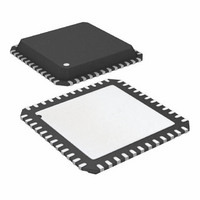AD9233BCPZ-125 Analog Devices Inc, AD9233BCPZ-125 Datasheet - Page 29

AD9233BCPZ-125
Manufacturer Part Number
AD9233BCPZ-125
Description
IC ADC 12BIT 80/105/125 48-LFCSP
Manufacturer
Analog Devices Inc
Datasheet
1.AD9233BCPZ-125.pdf
(44 pages)
Specifications of AD9233BCPZ-125
Data Interface
Serial, SPI™
Number Of Bits
12
Sampling Rate (per Second)
125M
Number Of Converters
3
Power Dissipation (max)
425mW
Voltage Supply Source
Single Supply
Operating Temperature
-40°C ~ 85°C
Mounting Type
Surface Mount
Package / Case
48-VFQFN, CSP Exposed Pad
Resolution (bits)
12bit
Sampling Rate
125MSPS
Input Channel Type
Differential, Single Ended
Supply Voltage Range - Analog
1.7V To 1.9V
Lead Free Status / RoHS Status
Lead free / RoHS Compliant
For Use With
AD9233-125EBZ - BOARD EVALUATION FOR AD9233
Lead Free Status / RoHS Status
Lead free / RoHS Compliant, Lead free / RoHS Compliant
Available stocks
Company
Part Number
Manufacturer
Quantity
Price
Company:
Part Number:
AD9233BCPZ-125
Manufacturer:
FSC
Quantity:
9 440
Company:
Part Number:
AD9233BCPZ-125
Manufacturer:
ADI
Quantity:
455
Part Number:
AD9233BCPZ-125
Manufacturer:
ADI/亚德诺
Quantity:
20 000
DEFAULT OPERATION AND JUMPER SELECTION
SETTINGS
The following is a list of the default and optional settings or
modes allowed on the AD9233 Rev. A evaluation board.
POWER
Connect the switching power supply that is supplied in the
evaluation kit between a rated 100 V ac to 240 V ac wall outlet
at 47 Hz to 63 Hz and P500.
VIN
The evaluation board is set up for a double balun configuration
analog input with optimum 50 Ω impedance matching out to
70 MHz. For more bandwidth response, the differential capacitor
across the analog inputs can be changed or removed (see Table 8).
The common mode of the analog inputs is developed from the
center tap of the transformer via the CML pin of the ADC. See
the Analog Input Considerations section for more information.
VREF
VREF is set to 1.0 V by tying the SENSE pin to ground via
JP507 (Pin 1 and Pin 2). This causes the ADC to operate in
2.0 V p-p full-scale range. A separate external reference option
is also included on the evaluation board. Simply connect JP507
between Pin 2 and Pin 3, connect JP501, and provide an external
reference at E500. Proper use of the VREF options is detailed in
the Voltage Reference section.
RBIAS
RBIAS requires a 10 kΩ (R503) to ground and is used to set the
ADC core bias current.
CLOCK
The default clock input circuitry is derived from a simple
transformer-coupled circuit using a high bandwidth 1:1
impedance ratio transformer (T503) that adds a very low
amount of jitter to the clock path. The clock input is 50 Ω
terminated and ac-coupled to handle single-ended sine wave
inputs. The transformer converts the single-ended input to a
differential signal that is clipped before entering the ADC
clock inputs.
PDWN
To enable the power-down feature, connect JP506, shorting the
PDWN pin to AVDD.
CSB
The CSB pin is internally pulled-up, setting the chip into
external pin mode, to ignore the SDIO and SCLK information.
To connect the control of the CSB pin to the SPI circuitry on the
evaluation board, connect JP1 Pin 1 and Pin 2. To set the chip
into serial pin mode and to enable the SPI information on the
SDIO and SCLK pins, tie JP1 low (connect Pin 2 and Pin 3) in
the always enabled mode.
Rev. A | Page 29 of 44
SCLK/DFS
If the SPI port is in external pin mode, the SCLK/DFS pin sets the
data format of the outputs. If the pin is left floating, the pin is
internally pulled down, setting the default condition to binary.
Connecting JP2 Pin 2 and Pin 3 sets the format to twos
complement. If the SPI port is in serial pin mode, connecting
JP2 Pin 1 and Pin 2 connects the SCLK pin to the on board
SPI circuitry. See the Serial Port Interface (SPI) section for
more details.
SDIO/DCS
If the SPI port is in external pin mode, the SDIO/DCS pin acts
to set the duty cycle stabilizer. If the pin is left floating, the pin is
internally pulled up, setting the default condition to DCS enabled.
To disable the DCS, connect JP3 Pin 2 and Pin 3. If the SPI port
is in serial pin mode, connecting JP3 Pin 1 and Pin 2 connects the
SDIO pin to the on-board SPI circuitry. See the Serial Port
Interface (SPI) section for more details.
ALTERNATIVE CLOCK CONFIGURATIONS
A differential LVPECL clock can also be used to clock the ADC
input using the
the components listed in Table 16 need to be populated.
Consult the
To configure the analog input to drive the
the default transformer option, the following components need
to be added, removed, and/or changed.
•
•
•
If using an oscillator, two oscillator footprint options are also
available (OSC500) to check the performance of the ADC.
JP508 provides the user flexibility in using the enable pin, which
is common on most oscillators. Populate OSC500, R575, R587,
and R588 to use this option.
Remove R507, R508, C532, and C533 in the default
clock path.
Populate R505 with a 0 Ω resistor and C531 in the default
clock path.
Populate R511, R512, R513, R515 to R524, U500, R580,
R582, R583, R584, C536, C537, and R586.
AD9515
AD9515
data sheet for further information.
(U500). When using this drive option,
AD9515
instead of
AD9233
















